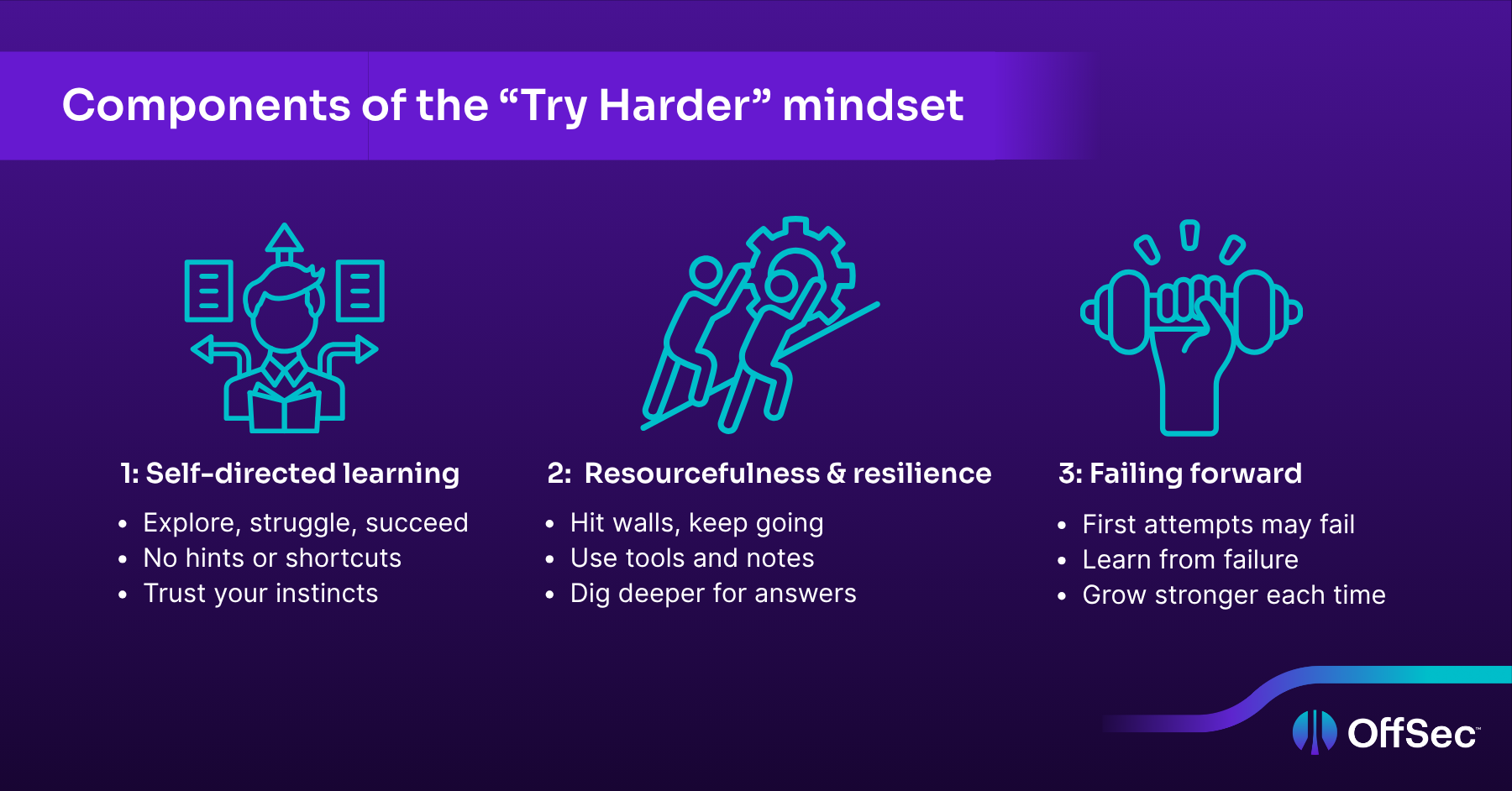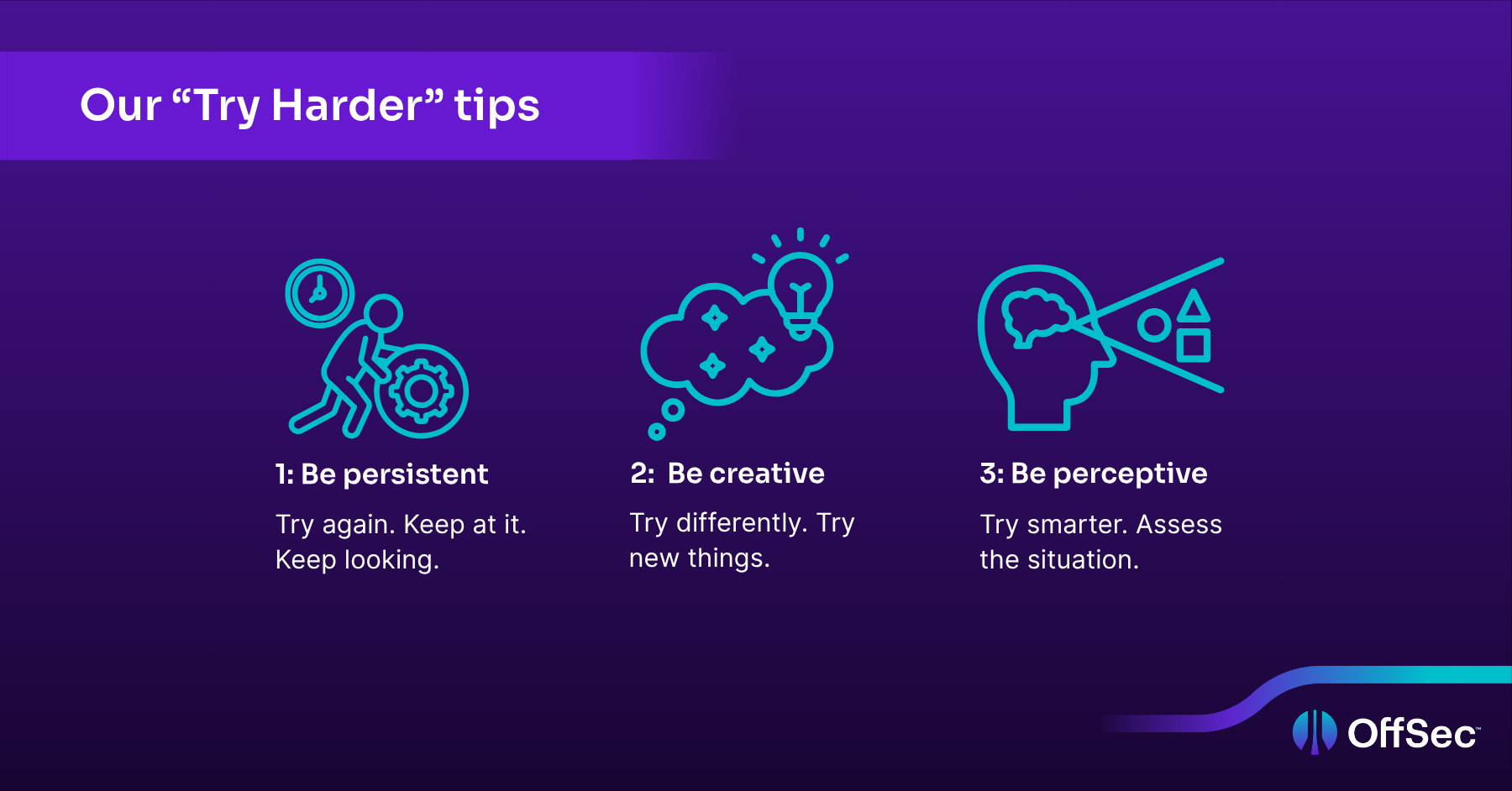At OffSec, two words echo louder than any slogan: “Try Harder.” The deeper you venture into the OffSec ecosystem, whether as a learner, team member, or leader, the more you realize: “Try Harder” isn’t just a motto. It’s a way of life.
And full disclosure: it doesn’t mean Try Harder until you’re mentally (or physically) burned out, nor does it mean ‘Pay’ Harder.
So, what do we really mean when we say “Try Harder”? Let’s break it down!
The history of “Try Harder”
Before it became OffSec’s unofficial mantra, “Try Harder” started as a simple suggestion to a frustrated student. Over a decade ago, during a conversation in an IRC channel, a learner expressed frustration with a tough exercise, insisting they had “tried everything.”
The response they received? “Have you tried harder?”
That short, sharp question stuck. It captured the heart of OffSec’s approach: we don’t hand out easy answers because that’s not how real-world skills are built. Instead, we challenge learners to persist, to explore every avenue, and to own their journey.
Over time, Try Harder evolved from a bit of tough love into something far more meaningful: a mindset that empowers learners and professionals alike to face complexity with grit, curiosity, and resilience.
What “Try Harder” really means
When Ning, OffSec’s CEO, first joined, she, like many, thought “Try Harder” was just a tagline, but immersion in OffSec’s culture revealed something far richer. Over time, the phrase evolved from an external expectation into a deeply personal ethos that builds confidence, compassion, and clarity of purpose.
“Try Harder” is not just about pushing yourself beyond limits. It’s about cultivating a mindset of ownership, grit, and growth. What the phrase does not represent is glorifying burnout or blind persistence. Instead, it’s a structured, deliberate approach to overcoming challenges.
As Ning puts it: “It’s not just a motto—it’s a mindset. And once you internalize it, it stays with you everywhere you go.”
Why Try Harder?
It’s a fair question. Why should someone try harder, especially when a challenge feels impossible or progress seems out of reach?
Because at OffSec, we don’t just teach techniques. We give you a mindset that lasts and can take you throughout your career and beyond. The world of information security doesn’t hand out neat instructions or guaranteed solutions. It demands persistence, adaptability, and sharp critical thinking under pressure.
That process of not giving up, of getting creative, of growing through setbacks, is where the real transformation happens. And that’s exactly what our learners take with them.
Components of the “Try Harder” mindset
So what does “Try Harder” actually look like in practice? It’s easy to assume it’s just about working longer, pushing harder, or refusing to give up. But it’s much more intentional than that. The mindset is built on specific habits, attitudes, and disciplines that turn pressure into purpose.

These core components of the mindset offer critical support throughout your learning journey:
- Self-directed learning: Exams demand that you think for yourself. It’s not about having all the answers upfront but having the willingness to explore, struggle, and experiment until a breakthrough is achieved. There are no hints, walkthroughs, or shortcuts. “Try Harder” here means trusting your own capacity to explore, research, and adapt.
- Resourcefulness and resilience: You will hit walls. Machines won’t yield easily. But that’s the point. “Try Harder” teaches you to maximize your tools, notes, and reasoning, because the answer is usually there if you look deeper.
- Failing forward: Many learners don’t pass on the first try, and that’s okay. Each attempt strengthens your approach, sharpens your instincts, and builds the mental stamina required not just to pass, but to perform like a real-world professional. Trying harder doesn’t mean not failing; it means failing smarter each time.
Our top tips:
-
Be persistent
When we feel like we’ve hit a brick wall, stepping away for a moment and taking a break is usually the best advice. Once we sit back down, we’re forced to reintroduce ourselves to the problem, and often this new perspective is just what we needed. Being persistent often means pressing ‘pause’ for a moment.
It’s also important to remember that mistakes and failures are part of the process. Sometimes a particular vector just seems like it should be more effective. The first step in developing persistence, it seems, is looking for why or how a particular approach is failing. Often, this will lead to new approaches and new ideas.
There is an element of patience to this as well. Thomas Edison once quipped that “the most certain way to succeed is always to try just one more time.” That’s what we ask of our students.
In other words, try again. Keep at it. Keep looking.
-
Be creative
The most persistent approach is rather useless if we’re not trying new things. Many security flaws are either the result of or can cause unexpected behaviors. It follows that a successful student is one who can think “outside the box” a bit.

To clarify: we’re not asking students to blindly stab in the dark, but when things aren’t going as planned, we can’t simply resort to checking our work against an example in a book, searching for typos or a misplaced semicolon. At times, penetration testing can be a bit like looking for a needle in the proverbial haystack, so being creative means applying an understanding of information security concepts to consider (and test!) a wide variety of ideas.
In other words, try differently.
-
Be perceptive
Situational awareness is a critical skill for any information security professional. We don’t just mean knowing what resources are available, or when to walk away from one approach and try something new, though perception does start there.
It’s critically important to be aware of how much time is left in an exam (or, for that matter, an assessment) and how to best use that time. Brute-force attacks, for example, can be incredibly time-consuming. On the other hand, a different approach may be efficient and effective, but if a student isn’t confident and well-practiced, they may find themselves still knocking at the door when the clock runs out.
Making time to step back and actively assess a situation is critical to being able to make good decisions. This sort of perception might not come naturally, but it’s a necessary skill.
In other words, try smarter.
Ready to Try Harder?
Ultimately, “Try Harder” isn’t about perfection. It’s not a license for burnout. And it’s certainly not a solitary pursuit. It’s a call to lean into discomfort with courage, to grow through mistakes, and to carry that growth with you into every domain of life.
Our goal is to provide the best and most comprehensive training that leaves our students with both the techniques and the disposition necessary to be effective and successful beyond the classroom. We carefully designed all of our courses and labs to teach the mindset and the work (not just the results). It’s also why our exams aren’t necessarily easy — they are as hands-on and in-depth as the courses themselves.
Ready to try harder? Whether you’re just starting your cybersecurity journey or pushing toward your next certification, OffSec is here to challenge, support, and transform you.
Explore our courses to experience the mindset that sets OffSec learners apart!
Prefer to listen instead? Check out our podcast “Resilience in Bytes: Mastering the ‘Try Harder’ Philosophy” as we dive into the mindset that’s helping OffSec learners grow and succeed.

